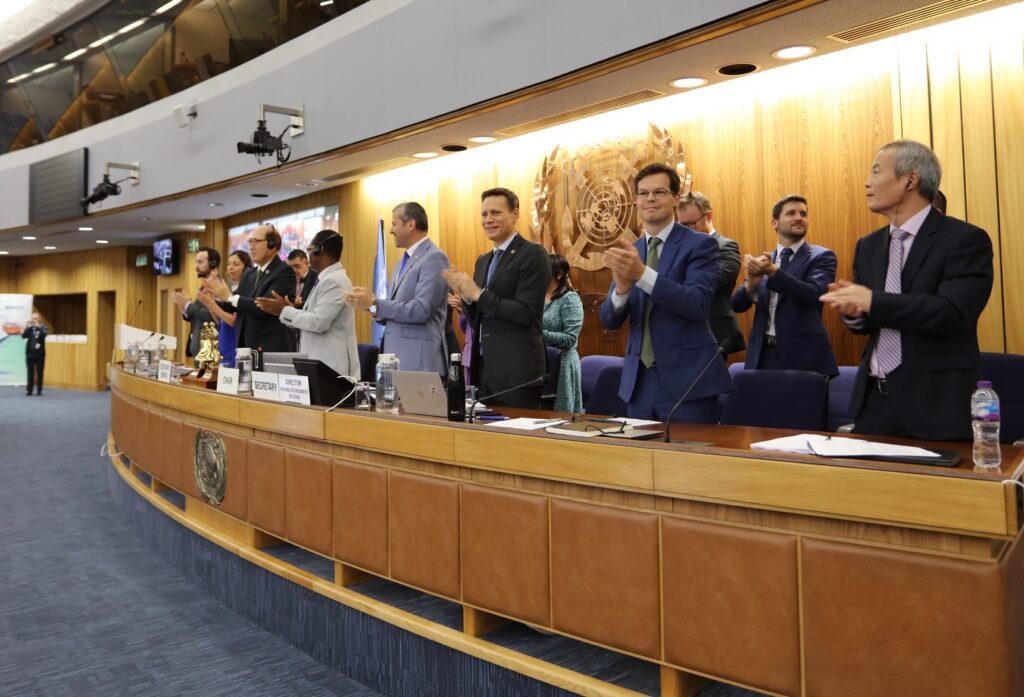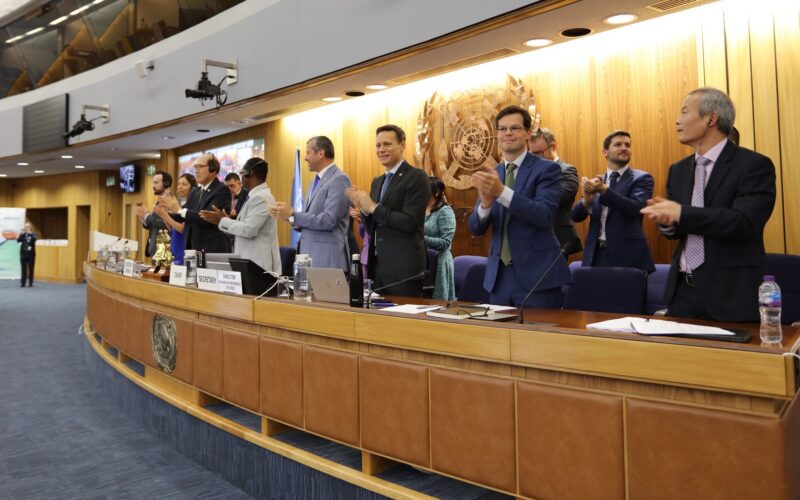(LONDON) — Member states of the International Maritime Organization (IMO), meeting at the Marine Environment Protection Committee (MEPC 80), have adopted the 2023 IMO Strategy on Reduction of GHG Emissions from Ships, with enhanced targets to tackle harmful emissions.
The revised IMO GHG Strategy includes an enhanced common ambition to reach net-zero greenhouse gas (GHG) emissions from international shipping close to 2050, a commitment to ensure an uptake of alternative zero and near-zero GHG fuels by 2030, as well as indicative checkpoints for 2030 and 2040.
“The adoption of the 2023 IMO Greenhouse Gas Strategy is a monumental development for IMO and opens a new chapter toward maritime decarbonization,” said IMO Secretary-General Kitack Lim. “At the same time, it is not the end goal, it is in many ways a starting point for the work that needs to intensify even more over the years and decades ahead of us. However, with the revised strategy that you have now agreed on, we have a clear direction, a common vision, and ambitious targets to guide us to deliver what the world expects from us.
“Above all, it is particularly meaningful, to have unanimous support from all member states. In this regard, I believe that we have to pay more attention to support developing countries, in particular SIDS (small island developing states) and LDCs (least developed countries), so that no one is left behind,” he said.

The IMO is the United Nations specialized agency with responsibility for developing global standards for shipping and supporting countries to implement those rules.
Elements of the strategy are outlined below:
Vision
IMO remains committed to reducing GHG emissions from international shipping and, as a matter of urgency, aims to phase them out as soon as possible, while promoting, in the context of this strategy, a just and equitable transition.
Levels of ambition
1) Carbon intensity to decline through further improvement of the energy efficiency of new ships, with an aim of strengthening design efficiency requirements.
2) Carbon intensity of international shipping to decline. Reduce CO2 emissions in transport work, as an average across international shipping, by at least 40 percent by 2030 compared to 2008.
3) Uptake of zero or near-zero GHG emission technologies, fuels and/or energy sources to represent at least 5 percent, striving for 10 percent, of the energy used by international shipping by 2030.
4) GHG emissions from international shipping to reach net zero by or around, i.e. close to 2050, taking into account different national circumstances, while pursuing efforts toward phasing them out as called for in the vision consistent with the long-term temperature goal set out in Article 2 of the Paris Agreement.
Indicative checkpoints
1) To reduce the total annual GHG emissions from international shipping by at least 20 percent, striving for 30 percent, by 2030 compared to 2008.
2) To reduce the total annual GHG emissions from international shipping by at least 70 percent, striving for 80 percent, by 2040 compared to 2008.
Basket of candidate mid-term GHG reduction measures
The 2023 GHG Strategy states that a basket of candidate measure(s), delivering on the reduction targets, should be developed and finalized comprised of both a technical element, namely a goal-based marine fuel standard regulating the phased reduction of the marine fuel’s GHG intensity; and an economic element, on the basis of a maritime GHG emissions pricing mechanism.
The candidate economic elements will be assessed observing specific criteria to be considered in the comprehensive impact assessment, with a view to facilitating the finalization of the basket of measures.
The mid-term GHG reduction measures should effectively promote the energy transition of shipping and provide the world fleet a needed incentive while contributing to a level playing field and a just and equitable transition.
Impacts on states
The strategy says that the impacts on states of a measure/combination of measures should be assessed and taken into account as appropriate before adoption of the measure in accordance with the revised procedure for assessing impacts on states of candidate measures. Particular attention should be paid to the needs of developing countries, especially SIDS and LDCs.
Barriers and supportive actions; capacity-building and technical cooperation; R&D
In the strategy, the committee recognizes that developing countries, in particular LDCs and SIDS, have special needs with regard to capacity-building and technical cooperation. An appendix provides an overview of relevant IMO initiatives supporting the reduction of GHG emissions from ships.
These include: the IMO Integrated Technical Cooperation Programme (ITCP); voluntary multi-donor trust fund (GHG TC-Trust Fund); the Global Maritime Technologies Cooperation Centres (MTCC) Network (GMN) EU-supported project; the Norway-supported Green Voyage 2050 project; the GHG-SMART Programme and Future Fuels and Technology for Low- and Zero-Carbon Shipping Projects (FFT project) supported by Republic of Korea; the UNDP-GEF GloFouling Partnerships project; the Norway-supported TEST Biofouling (Transfer of Environmentally Sound Technologies) project; the Kingdom of Saudi Arabia-supported IMO CARES (Coordinated Actions to Reduce Emissions from Shipping) Foundation Project; the IMO-UNEP-Norway Innovation Forum; the IMO-EBRD-World Bank co-led Financing Sustainable Maritime Transport (FIN-SMART) Roundtable; and the NextGEN (Green and Efficient Navigation) portal and NextGEN Connect projects.
For more on the IMO action, click here. Download the strategy by clicking here.
– International Maritime Organization

